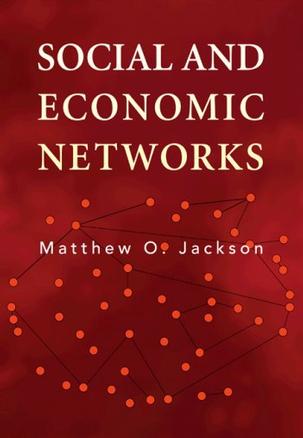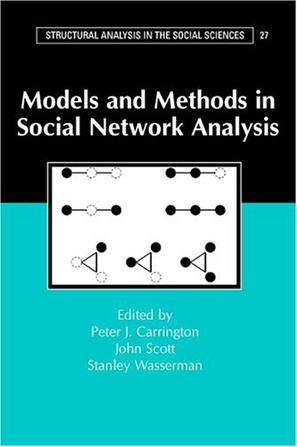-

网络科学导论
对各种复杂网络的定量与定性特征的科学理解已成为网络时代科学研究中一个极其重要的挑战性课题,网络科学就是一门正在兴起的面对这一挑战的交叉性学科。本书致力于系统地介绍网络科学的基本概念、思想和方法,使得具有高等数学基础的读者都能够看懂,并具备把网络科学方法用于实际网络分析的能力。为此,本书没有过多地陷入数学和物理推导,而是更为关注网络科学的思维习惯和研究方式。本书在概要介绍了网络科学的背景和研究意义之后,分为四个部分详细介绍了网络基本概念、网络拓扑性质、网络拓扑模型和网络动力学。 本书适合作为研究生和高年级本科生的网络科学教材,也可供自然科学、工程技术科学和社会科学领域的研究人员与学生参考。 -

The Structure and Dynamics of Networks
From the Internet to networks of friendship, disease transmission, and even terrorism, the concept - and the reality - of networks has come to pervade modern society. But what exactly is a network? What different types of networks are there? Why are they interesting, and what can they tell us? In recent years, scientists from a range of fields - including mathematics, physics, computer science, sociology, and biology - have been pursuing these questions and building a new 'science of networks.' This book brings together, for the first time, a set of seminal articles representing research from across these disciplines. It is an ideal sourcebook for the key research in this fast-growing field. The book is organized into four sections, each preceded by an editors' introduction summarizing its contents and general theme. The first section sets the stage by discussing some of the historical antecedents of contemporary research in the area. From there the book moves to the empirical side of the science of networks before turning to the foundational modeling ideas that have been the focus of much subsequent activity. The book closes by taking the reader to the cutting edge of network science - the relationship between network structure and system dynamics. From network robustness to the spread of disease, this section offers a potpourri of topics on this rapidly expanding frontier of the new science. -

Social Network Analysis
The revised and updated edition of this bestselling text provides an accessible introduction to the theory and practice of network analysis in the social sciences. It gives a clear and authoritative guide to the general framework of network analysis, explaining the basic concepts, technical measures and reviewing the available computer programs. The book outlines both the theoretical basis of network analysis and the key techniques for using it as a research tool. Building upon definitions of points, lines and paths, John Scott demonstrates their use in clarifying such measures as density, fragmentation and centralization. He identifies the various cliques, components and circles into which networks are formed, and outlines an approach to the study of socially structured positions. He also discusses the use of multidimensional methods for investigating social networks. Social Network Analysis is an invaluable resource for researchers across the social sciences and for students of social theory and research methods. -

The Filter Bubble
In December 2009, Google began customizing its search results for each user. Instead of giving you the most broadly popular result, Google now tries to predict what you are most likely to click on. According to MoveOn.org board president Eli Pariser, Google's change in policy is symptomatic of the most significant shift to take place on the Web in recent years-the rise of personalization. In this groundbreaking investigation of the new hidden Web, Pariser uncovers how this growing trend threatens to control how we consume and share information as a society-and reveals what we can do about it.Though the phenomenon has gone largely undetected until now, personalized filters are sweeping the Web, creating individual universes of information for each of us. Facebook-the primary news source for an increasing number of Americans-prioritizes the links it believes will appeal to you so that if you are a liberal, you can expect to see only progressive links. Even an old-media bastion like T -

Social and Economic Networks
Review Lucid and comprehensive, Jackson's book elegantly synthesizes several important strands of network science from sociology, physics, mathematics, computer science, and economics. It will be an immensely useful reference for researchers and students alike. (Duncan Watts, Columbia University ) Product Description Networks of relationships help determine the careers that people choose, the jobs they obtain, the products they buy, and how they vote. The many aspects of our lives that are governed by social networks make it critical to understand how they impact behavior, which network structures are likely to emerge in a society, and why we organize ourselves as we do. In Social and Economic Networks, Matthew Jackson offers a comprehensive introduction to social and economic networks, drawing on the latest findings in economics, sociology, computer science, physics, and mathematics. He provides empirical background on networks and the regularities that they exhibit, and discusses random graph-based models and strategic models of network formation. He helps readers to understand behavior in networked societies, with a detailed analysis of learning and diffusion in networks, decision making by individuals who are influenced by their social neighbors, game theory and markets on networks, and a host of related subjects. Jackson also describes the varied statistical and modeling techniques used to analyze social networks. Each chapter includes exercises to aid students in their analysis of how networks function. This book is an indispensable resource for students and researchers in economics, mathematics, physics, sociology, and business. -

Models and Methods in Social Network Analysis (Structural Analysis in the Social Sciences)
Models and Methods in Social Network Analysis presents the most important developments in quantitative models and methods for analyzing social network data that have appeared during the 1990s. Intended as a complement to Wasserman and Faust's Social Network Analysis: Methods and Applications, it is a collection of articles by leading methodologists reviewing advances in their particular areas of network methods. Reviewed are advances in network measurement, network sampling, the analysis of centrality, positional analysis or blockmodelling, the analysis of diffusion through networks, the analysis of affiliation or 'two-mode' networks, the theory of random graphs, dependence graphs, exponential families of random graphs, the analysis of longitudinal network data, graphical techniques for exploring network data, and software for the analysis of social networks.